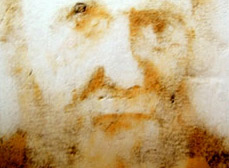From Nature to Natural Selection
Art installation uses the elements to explore evolution

Outside the Metcalf Science Center, a portrait of Charles Darwin will undergo its own form of evolution.
In an installation that began this month and continues through April, artist Esther Solondz is using salt, rust, and water to create images of famous scientists on the concrete of Metcalf Plaza. Titled The Evolution of Darwin, the exhibition blends art and science to explore what transformation and evolution mean in both fields.
Solondz creates the portraits using iron filings, which are placed between two pieces of cotton gauze and then set on a concrete surface. She then sets compressed salt sculptures on top of each image; over time, the salt dissolves, the filings rust, and the portrait is left on both the gauze and on the concrete below.
“I’m very interested in evolutionary biology, and it seemed like the way the pieces evolved was sort of the perfect metaphor for the idea of selection,” says Solondz, who is based in Providence, R.I. “The whole thing was one large natural process.”
She says she was inspired by several factors, particularly the idea that Darwin’s theory of evolution in The Origin of the Species is in itself an older idea that has continued to evolve and change since its introduction. She worked with John Straub, a College of Arts and Sciences professor of chemistry, as well as with the physics and biology departments, to fine-tune the process and determine how the iron filings would rust over time.
The scientists featured in the exhibition, all of whom are involved in some form of evolutionary biology, include historic icons Darwin and Gregor Mendel as well as more contemporary researchers such as Nobel Prize-winning geneticist Barbara McClintock and ethologist Richard Dawkins.
The work relies on natural elements for its completion, making the resulting portraits both malleable and unpredictable. As the installation continues throughout the academic year, Solondz expects to begin layering and changing the portraits as they fade.
“These things start out in one place, and then you just sort of leave them,” she says. “I never know quite what’s going to happen.”
The Evolution of Darwin can be viewed on Metcalf Plaza, 590 Commonwealth Ave., through April.
Jessica Ullian can be reached at jullian@bu.edu.